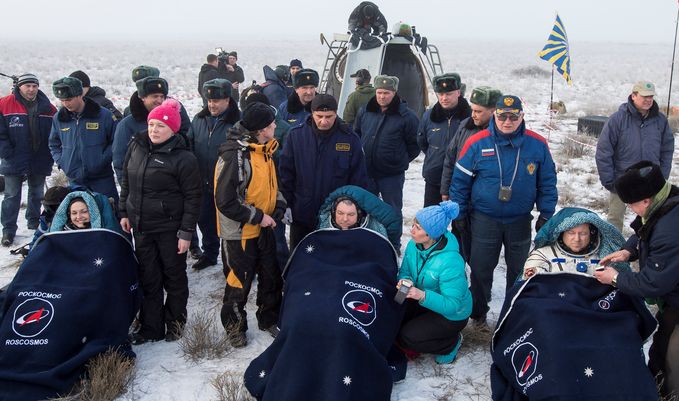Main » Entries archive
 Russian launched Korean satellite. Russian launched Korean satellite.
On March 25, 2015 at 22:08 UTC (March 26 at 01:08 Moscow time) a Soviet-era "Dnepr” ballistic missile blasted off from southern Russia. The "Dnepr” rocket launched from an underground silo at a space base near Yasny, Russia, a small community in the Orenburg region in the southern part of the country. The launch was performed by Strategic Rocket Forces of the Russian Federation in according to the agreement with Kosmotras, a Moscow-based company with joint Russian-Ukrainian ownership that oversees the commercial exploitation of the Dnepr rocket. The rocket orbited the “KompSat-3A” (Korean Multi-purpose Satellite 3) Earth observation satellite.
Looking through: 1231 |
Date: 29.03.2015
| Rating: 0.0/0
|
 US launched navigation satellite. US launched navigation satellite.
On March 25, 2015 at 14:36 UTC the “Delta-4” rocket-carrier was launched from Cape Canaveral launch site of US Air Force. The launch was performed by United Launch Alliance supported by the 45th Space Wing of US Air Force. The rocket orbited GPS Block IIF-9 navigation satellite.
Looking through: 1245 |
Date: 29.03.2015
| Rating: 0.0/0
|
 Russia launched the Express-AM7 satellite. Russia launched the Express-AM7 satellite.
On March 18, 2015 at 22:05 UTC (on March 19 at 01:05 Moscow time) the Russian "Proton-M” rocket-carrier was launched from Baykonur Cosmodrome. The rocket equipped with the "Briz-M” booster orbited the “Express-AM7” telecommunication satellite. Built in Europe by Airbus Defense and Space, the “Express-AM7” satellite will provide television and radio broadcasts, broadband access, multimedia, data, telephony and mobile communications services.
Looking through: 1301 |
Date: 28.03.2015
| Rating: 0.0/0
|
 The 50th anniversary of the first spacewalk. The 50th anniversary of the first spacewalk.
On 18 March 1965, Soviet cosmonaut Alexei Leonov took the first spacewalk. He became the first person to leave the confines of his spacecraft while in orbit and float in the vacuum of space. Alexei Leonov, who with Pavel Belyayev was flying onboard the Soviet “Voskhod-2” spacecraft, accomplished the first extra-vehicular activity – EVA, or spacewalk – on what was only the 14th piloted spaceflight in history.

The Russian postal stationery (a post card) devoted to the 50th anniversary of the first spacewalk. Total edition is 15 000 post cards. |
 US launched satellite quartet. US launched satellite quartet.
On March 13, 2015 at 02:44 UTC the " Atlas V” rocket-carrier was launched from the Cape Canaveral US Air Force Station in Florida. The launch was performed by United Launch Alliance supported by the 45th Space Wing of US Air Force. The rocket orbited 4 MMS (Magnetospheric Multiscale) satellites.
The satellites will stay together in cosmic terms, formation-flying around the Earth in a carefully choreographed dance to gain three-dimensional insights into the fundamental processes responsible for transferring energy from the solar wind to Earth’s magnetosphere. This experiment promises to teach scientists about how and why magnetic reconnection occurs, which is the explosive disconnection and reconfiguring of the magnetic field lines.
Looking through: 1246 |
Date: 24.03.2015
| Rating: 0.0/0
|
 Russian Soyuz TMA-14M spacecraft landed. Russian Soyuz TMA-14M spacecraft landed.
On March 12, 2015 at 02:14 UTC the Russian “Soyuz TMA-14M” landing capsule landed safely in a distance of 147 kilometers south-east from the city of Dzhezkazgan, Kazakhstan.

photo by NASA
The spacecraft delivered to Earth the 3 members of ISS’s Expedition 42 – Russian cosmonauts Aleksandr Samokutyaev and Elena Serova as well as American astronaut Barry Wilmore
They spent in space 167 days, 05 hours, 49 minutes.
Three other ISS crew members – Russian cosmonaut Ant
...
Read more »
|
 Russian Soyuz TMA-14M undocked from ISS. Russian Soyuz TMA-14M undocked from ISS.
On March 11, 2015 at 22:44 UTC (on March 12 at 01:44 Moscow time) the Russian “Soyuz TMA-14M” spacecraft undocked from the Russian "Poisk” (MIM-2) module of the International Space Station to deliver to Earth the 3 members of Expedition 42 – Russian cosmonauts Aleksandr Samokutyaev and Elena Serova as well as American astronaut Barry Wilmore. |
 CubeSat satellites launched from Space Station. CubeSat satellites launched from Space Station.
On March 05, 2015 at 01:45 UTC the “Flock-1b.11” and “Flock-1b.12” CubeSat satellites were launched from the International Space Station. CubeSat satellites were deployed from the Japanese “Kibo” module of the ISS. |
 Four CubeSat satellites launched from Space Station. Four CubeSat satellites launched from Space Station.
On March 04, 2015 at 01:20 UTC the “TechEdSat-4” (Technical and Educational Satellite-4, TES-4) and “GEARRSat” (Globalstar Experiment And Risk Reduction Satellite) CubeSat satellites were launched from the International Space Station. At the same day MicroMAS (Micro-sized Microwave Atmospheric Satellite) and LambdaSat CubeSat satellites were launched from the International Space Station. The 4 CubeSat satellites were deployed from the Japanese “Kibo” module of the ISS. The satellites were delivered to the ISS by the “Cygnus” unmanned supply spacecraft in July 2014. |
 Some more CubeSat satellites launched from Space Station. Some more CubeSat satellites launched from Space Station.
On March 03, 2015 at 03:00 UTC the “Flock-1D-1” and “Flock-1D-2” CubeSat satellites were launched from the International Space Station. On March 03, 2015 at 10:50 UTC the “Flock-1b.5” and “Flock-1b.6” CubeSat satellites were launched from the International Space Station. CubeSat satellites were deployed from the Japanese “Kibo” module of the ISS. The satellites were delivered to the ISS by the “Cygnus” unmanned supply spacecraft in July 2014. |
|





